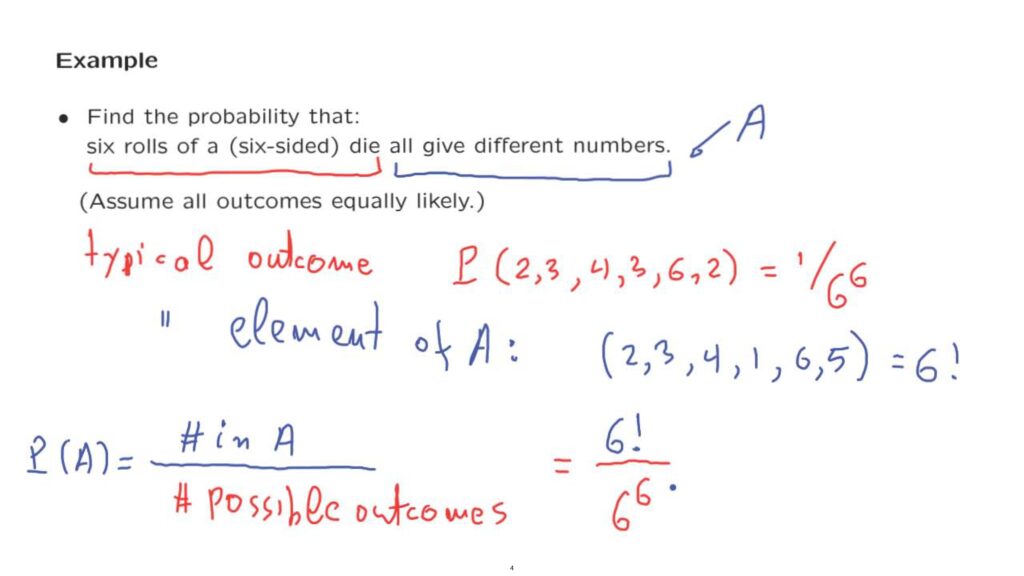We will now use counting to solve a simple probabilistic problem.
We have in our hands an ordinary six-sided die which we are going to roll six times.
So this is our probabilistic experiment.
And we’re interested in the probability of a certain event, the event that the six rolls result in different numbers.
So let us give a name to that event and call it event A.
So we wish to calculate the probability of this event.
But before we can even get started answering this question, we need a probabilistic model.
We need to make some assumptions, and the assumption that we’re going to make is that all outcomes of this experiment are equally likely.

This is going to place us within a discrete uniform probabilistic model so that we can calculate probabilities by counting.
In particular, as we discussed earlier in this lecture, the probability of an event A is going to be the number of elements of the set A, the number of outcomes that make event A occur, divided by the total number of possible outcomes, which is the number of elements in our sample space.
So let us start with the denominator, and let us look at the typical outcomes of this experiment.
A typical outcome is something like this sequence, 2, 3, 4, 3, 6, 2.
That’s one possible outcome.
How many outcomes of this kind are there? Well, we have 6 choices for the result of the first roll, 6 choices for the result of the second roll, and so on.
And since we have a total of 6 rolls, this means that there is a total of 6 to the 6th power possible outcomes, according to the Counting Principle.

And by the way, since we have so many possible outcomes and we assume that they are equally likely, the probability of each one of them would be 1 over 6 to the 6th.
Incidentally, that’s the same number, the same answer, you would get if you were to assume, instead of assuming directly that all outcomes are equally likely, to just assume that the different rolls are rolls of a fair six-sided die, so the probability of getting a 2 is 1/6, and also that the different rolls are independent of each other.
So in that case, the probability, let’s say, of this particular sequence would be the probability of obtaining a 2, which is 1/6, times the probability that we get a 3 at the next roll, which is 1/6, times 1/6 times 1/6 and so on, and we get the same answer, 1 over 6 to 6th.
So we see that this assumption of all outcomes being equally likely has an alternative interpretation in terms of having a fair die which is rolled independently 6 times.
Now, let us look at the event of interest, A.
What is a typical element of A? A typical element of A is a sequence of 6 rolls in which no number gets repeated.
So, for example, it could be a sequence of results of this kind, where each number appears just once.
So all the numbers appear exactly once in this sequence.
So what we need here is basically to have a permutation of the numbers 1 up to 6.
So these 6 numbers have to appear in an arbitrary order.
In how many ways can we order 6 elements? This is the number of permutations of a set of 6 elements and, as we discussed earlier, this is equal to 6 factorial.
So we have now counted the number of outcomes that make event A happen, which is 6 factorial.
And by calculating this ratio, we have obtained the probability of the desired event.
You can now pause and try to solve a problem of a similar kind.